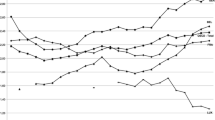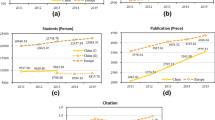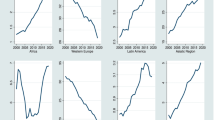Abstract
In this study we examined the resource–research relationship at China’s research universities. The stochastic frontier production function was employed in analyses of a panel data set on a group of the most research-intensive universities in China from 2000 to 2010. Results suggested overall tight relationships between various resources (including human resources, research expenditures, and research equipment) and research publications. Distinct patterns emerged when research publications were disaggregated by fields [i.e., science and engineering (SE) vs. non-science and engineering (non-SE)] and publishing venues (i.e., domestic vs. international journals). Research publications in SE, especially those published in international journals, depended heavily on all three resources, while research in non-SE depended more on human resources. In addition, results suggested that research in SE had shifted its focus from domestic to international publications during this period.

Similar content being viewed by others
Notes
These numbers do not include papers published in Chinese-media journals.
Authors’ own calculation based on data from Thomson Reuters. The calculation does not consider number of authors and author order for a particular paper. We take total number of papers and calculate the proportion of those papers that have authors from certain countries.
Authors’ own calculation based on data from Thomson Reuters. Any institutions with either “college” or “university” in their names are classified as higher education institutions. This, of course, would likely under-estimate the number of research papers affiliated with colleges and universities.
Research publications are traditionally divided between SE and non-SE fields. SE fields typically include Sciences, Technology, Engineering, and Mathematics, while non-SE fields include Social Sciences, Arts and Humanities, Business, and Education. As in many other studies, the use of “non-SE” simply indicates the division of broad research fields and does not reflect bias toward any particular fields.
References
Abbott, M., & Doucouliagos, C. (2003). The efficiency of Australian universities: A data envelopment analysis. Economics of Education Review, 22, 89–97.
Adams, J. D., and Clemmons. J. R. (2006). The growing allocative inefficiency of the U.S. higher education sector. National Bureau of Economic Research Working Paper No. 12683.
Adams, J. D., & Griliches, Z. (1998). Research productivity in a system of universities. Annals D’Economie et de Statistique, 49(50), 128–162.
Adams, J. D., Pendlebury, D., & Stembridge, B. (2013). Building bricks: Exploring the global research and innovation impact of Brazil, Russia, India, China, and South Korea. New York: Thomson Reuters.
Agasisti, T., & Johnes, G. (2010). Heterogeneity and the evaluation of efficiency: the case of Italian universities. Applied Economics, 42, 1365–1375.
Aigner, D., Lovell, C. A. K., & Schmidt, P. (1977). Formulation and estimation of stochastic frontier function models. Journal of Econometrics, 6, 21–37.
Altbach, P. G., & Balán, J. (Eds.). (2007). World class worldwide: Transforming research universities in Asia and Latin America. Baltimore: JHU Press.
Altbach, P. G., Reisberg, L., & Rumbley, L. E. (2010). Trends in global higher education: Tracking an academic revolution. Rotterdam: Sense Publishers.
Battese, G. E., & Coelli, T. J. (1988). Prediction of firm-level technical efficiencies with a generalized frontier production function and panel data. Journal of Econometrics, 38, 387–399.
Battese, G. E., & Coelli, T. J. (1992). Frontier production functions, technical efficiency and panel data: with application to paddy farmers in India. Journal of Productivity Analysis, 3, 153–169.
Bellas, M. L., & Toutkoushian, R. K. (1999). Faculty time allocations and research productivity: Gender, race and family effects. The Review of Higher Education, 22(4), 367–390.
Belotti, F., Daidone, S., Ilardi, G., and Atella, V. (2012). Stochastic frontier analysis using Stata. CEIS Tor Vergata research paper series 10.
Bland, C. J., Center, B. A., Finstad, D. A., Risbey, K. R., & Staples, J. G. (2005). A theoretical, practical, predictive model of faculty and department research productivity. Academic Medicine, 80, 225–237.
Bowen, H. R. (1980). The costs of higher education: How much do colleges and universities spend per student and how much should they spend?. San Francisco: Jossey-Bass.
Bowman, N. A., & Bastedo, M. N. (2009). Getting on the front page: Organizational reputation, status signals, and the impact of US News and World Report on student decisions. Research in Higher Education, 50(5), 415–436.
Brewer, D. J., Hentschke, G. C., & Eide, E. R. (2010). Theoretical concepts in the economics of education. In D. Brewer & P. McEwan (Eds.), International encyclopedia of education. Oxford: Elsevier.
Charlton, B. G., & Andras, P. (2007). Evaluating universities using simple scientometric research-output metrics: Total citation counts per university for a retrospective seven-year rolling sample. Science and Public Policy, 34(8), 555–563.
Chellaraj, G., Maskus, K. E., and Mattoo, A. (2005). The contribution of skilled immigration and international graduate students to U.S. innovation. World Bank Policy Research Working Paper Report No. 3588.
Cohen, A. M. (2007). The shaping of American higher education: Emergence and growth of the contemporary system. San Francisco: Wiley.
Cohn, E., Rhine, S. L. W., & Santos, M. C. (1989). Institutions of higher education as multi-product firms: Economies of scale and scope. The Review of Economics and Statistics, 71(2), 284–290.
Cornwell, C., Schmidt, P., & Sickles, R. C. (1990). Production frontiers with cross sectional and time-series variation in efficiency levels. Journal of Econometrics, 46, 185–200.
Cui, L. C. (2000). A study on the S&T policies of the CPC since 1949 (Doctoral thesis, The Party School of the Central Committee of C.P.C.). https://vpn.ccnu.edu.cn/kns/brief/,DanaInfo=epub.cnki.net+default_result.aspx.
DiMaggio, P. J., & Powell, W. W. (1983). The iron cage revisited: Institutional isomorphism and collective rationality in organizational fields. American Sociological Review, 48(2), 147–160.
Dong, B. L., Dan, Z. B., & Chen, Q. (2007). The modern history of higher education in China. Wuhan: Huazhong University of Science and Technology Press.
Dundar, H., & Lewis, D. R. (1995). Departmental productivity in American universities: Economies of scale and scope. Economics of Education Review, 14(2), 119–144.
Dundar, H., & Lewis, D. R. (1998). Determinants of research productivity in higher education. Research in Higher Education, 39(6), 607–631.
Ehrenberg, R. G. (2003). Reaching for the brass ring: The US News & World Report rankings and competition. The Review of Higher Education, 26(2), 145–162.
Ehrenberg, R. G., Rees, D. I., & Brewer, D. J. (1993). Institutional responses to increased external support for graduate students. Review of Economics and Statistics, 75, 671–682.
Ehrenberg, R. G., Rizzo, M. J., & Jakubson, G. H. (2007). Who bears the growing cost of science at universities? In P. E. Stephan & R. G. Ehrenberg (Eds.), Science and the University. Madison: University of Wisconsin Press.
Goldin, C. D., & Katz, L. F. (2009). The race between education and technology. Cambridge: Harvard University Press.
Goodall, A. H. (2009). Highly cited leaders and the performance of research universities. Research Policy, 38(7), 1079–1092.
Graves, P. E., Marchand, J. R., & Thompson, R. (1982). Economics departmental rankings: Research incentives, constraints, and efficiency. The American Economic Review, 72, 1131–1141.
Greene, W. (2005). Reconsidering heterogeneity in panel data estimators of the stochastic frontier model. Journal of Econometrics, 126, 269–303.
Hayhoe, R. (1996). China’s universities 1895–1995: A century of cultural conflict. New York: Garland Pub.
Hazelkorn, E. (2015). Rankings and the reshaping of higher education: The battle for world-class excellence. London: Palgrave Macmillan.
Johnes, J. (2004). Efficiency measurement. In G. Johnes & J. Johnes (Eds.), International handbook on the economics of education. Cheltenham: Edward Elgar.
Johnes, J. (2008). Efficiency and productivity change in the English higher education sector from 1996/97 to 2004/5. The Manchester School, 76, 653–674.
Johnes, G., & Johnes, J. (1993). Measuring the research performance of UK economics departments: Application of data envelopment analysis. Oxford Economic Papers, 45, 332–348.
Johnes, G., & Johnes, J. (2009). Higher education institutions’ costs and efficiency: Taking the decomposition a further step. Economics of Education Review, 28(1), 107–113.
Johnes, J., & Yu, L. (2008). Measuring the research performance of Chinese higher education institutions using data envelopment analysis. China Economic Review, 19(4), 679–696.
Jordan, J. M., Meador, M., & Walters, S. J. (1988). Effects of department size and organization on the research productivity of academic economists. Economics of Education Review, 7(2), 251–255.
Kalaitzidakis, P., Mamuneas, T. P., Savvides, A., & Stengos, T. (2004). Research spillovers among European and North-American economics departments. Economics of Education Review, 23, 191–202.
Kim, Y., & Schmidt, P. (2000). A review and empirical comparison of Bayesian and classical approaches to inference on efficiency levels in stochastic frontier models with panel data. Journal of Productivity Analysis, 14, 91–118.
Kumbhakar, S. C. (1990). Production frontiers, panel data and time-varying technical inefficiency. Journal of Econometrics, 46, 201–212.
Kumbhakar, S. C., & Lovell, C. A. K. (2000). Stochastic frontier analysis. Cambridge: Cambridge University Press.
Lee, B. (2011). Efficiency of research performance of Australian universities: A reappraisal using a bootstrap truncated regression approach. Economic Analysis and Policy, 41(3), 95–203.
Lee, Y. H., & Schmidt, P. (1993). A production frontier model with flexible temporal variation in technical inefficiency. In H. O. Fried, C. A. Knox Lovell, & S. S. Schmidt (Eds.), The measurement of productive efficiency: Techniques and applications. Oxford: Oxford University Press.
Leslie, L., Slaughter, S., Taylor, B., & Zhang, L. (2012). How do revenue variations affect expenditures within U.S. research universities? Research in Higher Education, 53, 614–639.
Liu, X., & Zhang, L. (2013). Flexibility at the core: What determines employment of part-time faculty in academia? Relations Industrielles/Industrial Relations, 68(2), 312–339.
Monks, J., & Ehrenberg, R. G. (1999). The impact of US News and World Report college rankings on admission outcomes and pricing decisions at selective private institutions (No. w7227). Cambridge: National Bureau of Economic Research.
Nelson, R. R., & Romer, P. M. (1996). Science, economic growth, and public policy. Challenge, 39(1), 9–21.
Pfeffer, J., & Salancik, G. R. (1978). The external control of organizations: A resource dependence perspective. New York: Harper and Row.
Pitt, M., & Lee, L. F. (1981). The measurement and sources of technical inefficiency in the Indonesian weaving industry. Journal of Development Economics, 9, 43–64.
Rey-Rocha, J., Martín-Sempere, M. J., & Garzón, B. (2002). Research productivity of scientists in consolidated vs. non-consolidated teams: The case of Spanish university geologists. Scientometrics, 55, 137–156.
Robst, J. (2000). Do state appropriations influence cost efficiency in public higher education? Applied Economic Letters, 7(11), 715–719.
Robst, J. (2001). Cost efficiency in public higher education institutions. Journal of Higher Education, 72(6), 730–750.
Rust, V. D., & Kim, S. (2012). The global competition in higher education. World Studies in Education, 13(1), 5–20.
Schmidt, P., & Sickles, R. C. (1984). Production frontiers with panel data. Journal of Business and Economic Statistics, 2, 367–374.
Slaughter, S., & Leslie, L. L. (1997). Academic capitalism: Politics, policies, and the entrepreneurial university. Baltimore: The Johns Hopkins University Press.
Smeby, J., & Try, S. (2005). Departmental contexts and faculty research activity in Norway. Research in Higher Education, 46, 593–619.
Stevens, A. P. (2005). A stochastic frontier analysis of English and Welsh Universities. Education Economics, 13(4), 355–374.
Titus, M. A., & Pusser, B. (2011). States’ potential enrollment of adult students: A stochastic frontier analysis. Research in Higher Education, 52(6), 555–571.
Toutkoushian, R. K., Porter, S. R., Danielson, C., & Hollis, P. R. (2003). Using publications counts to measure an institution’s research productivity. Research in Higher Education, 44, 121–148.
Varghese, N. V., Chien, C.-L., Montjourides, P., Tran, H., Sigdel, S., Katayama, H., & Chapman, D. (2014). The reshaping of higher education across Asia. Higher education in Asia: Expanding out, expanding up (pp. 15–34). UNESCO Institute for Statistics: Montreal.
Worthington, A. C., & Lee, B. (2008). Efficiency, technology and productivity change in Australian universities. Economics of Education Review, 27, 285–298.
Yang, C. G. (2009). The national strategy of establishing world-class universities. China Education Daily. http://www.jyb.cn/high/gjsd/200909/t20090928_313808.html [in Chinese].
Zhang, L. (2010). The use of panel data models in higher education policy studies. Higher education: Handbook of theory and research (pp. 307–349). Netherlands: Springer.
Zhang, L., & Ehrenberg, R. G. (2010). Faculty employment and R&D expenditures at Research universities. Economics of Education Review, 29, 329–337.
Zhang, H., Patton, D., & Kenney, M. (2013). Building global-class universities: Assessing the impact of the 985 Project. Research Policy, 42(3), 765–775.
Zhang, L., Powell, J. J., & Baker, D. P. (2015). Exponential Growth and the Shifting Global Center of Gravity of Science Production, 1900–2011. Change: The Magazine of Higher Learning, 47(4), 46–49.
Acknowledgments
This Research paper was made possible by NPRP Grant # [5-1021-5-159] from the Qatar National Research Fund (a member of Qatar Foundation).
Author information
Authors and Affiliations
Corresponding author
Appendix
Appendix
See Table 6.
Rights and permissions
About this article
Cite this article
Zhang, L., Bao, W. & Sun, L. Resources and Research Production in Higher Education: A Longitudinal Analysis of Chinese Universities, 2000–2010. Res High Educ 57, 869–891 (2016). https://doi.org/10.1007/s11162-016-9410-6
Received:
Published:
Issue Date:
DOI: https://doi.org/10.1007/s11162-016-9410-6




